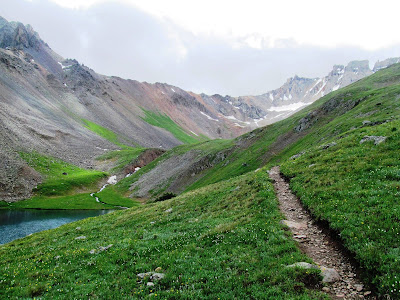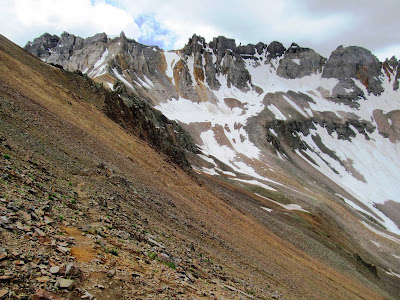The mountains have no “meaning,” they are
meaning; the mountains are. The sun is round. I ring with
life, and the mountains ring, and when I can hear it, there is a ringing that
we share.
—Peter Matthiessen, The Snow
Leopard
 |
| Upper Blue Lake basin |
Biologists
go to mountains to study altitudinal zonation, ecological islands, and endemic
species. Atmospheric scientists gather data on lapse rate, wind shear, and
microclimates. Hydrologists measure snowpack and monitor water quality; geologists
identify minerals and explain orogenic processes; geomorphologists speak their
own language of horns and arêtes, monadnocks and flyggbergs.
What,
though, of the phenomenology of altitude?—the sensation of standing in the hot
desert, looking longingly up at green-shouldered, snow-capped summits; the response
to peering down from a tree-lined ridge, seeing the land beyond open and brown
out; the experience of ascending a ravine or ridge, feeling the terrain become
more treacherous, the air thinner and colder? Measurements and explanations
aside, what do people see, think, and feel when transitioning from close, cosy forest
to open, exposed tundra to rock, snow, ice?
 |
| "MT. SNEFFELS WILDERNESS: Uncompahgre National Forest" ... "NO CAMPFIRES" |
I’ll
leave it to others (David Hinton, Robert MacFarlane, and Peter Matthiessen, for
example, whose Hunger Mountain, Mountains of the Mind, and The Snow Leopard are, respectively, three of my favorite
mountain-books) to write about the challenge of the climb or the particular joy
felt upon arriving at a summit. Rather, let me share my thoughts from a hike
the week after Wetterhorn. (Minimal rants about trails, signs, and
disrespectful visitors in “wilderness,” I promise.)
The
setting: Blue Lakes Trail, a popular route in the San Juan Mountains’ Mt.
Sneffels Wilderness, Uncompahgre National Forest, just west of Ridgway,
Colorado. A Friday, mid-July. Cool morning; clouds building; forecast for
afternoon storms.
 |
| View toward Blue Lakes Pass from County Road 7 |
The road
to the trailhead winds up a scenic valley, passing through aspen groves and
open meadows en route to a craggy wall of snow-laced peaks. Four years ago, I’d taken a photograph from
this road—a generic “Colorado
mountains” image I’ve used in lectures to illustrate phenomena like altitudinal
zonation and features like cirques—and was somewhat surprised and intrigued to
recognize the very spot at which I’d stood. (This set the tone for the entire
hike up to the lower lake—I kept encountering spots I remembered, kept
remembering moments I’d forgotten. The trail was littered with memories.) After parking in a dirt lot (not quite big
enough to accommodate the 40+ cars that were jammed in by mid-afternoon), lacing
up my boots, and strapping on my pack, I started up the trail.
The air
was cool, the ground soft. The forest was damp, pungent with the scent of
pines, grasses, and fresh dirt. Shafts of sunlight cut through the trees. For a
while, a stream tumbled merrily alongside, but then the trail turned away from
it and began switchbacking up the slope. Then all I could hear were my own
footsteps and heavy breathing. Surely, birds were singing and branches must
have been shuffling in the breeze; I think I passed some colorful flowers? But,
honestly, I wasn’t paying too much attention—part of my mind was in the past
(Was this where we’d stopped for a
rest and a chat?; Was that where we
found the first patch of snow?) and part of my mind was on the future (Would Lower Blue
Lake
 |
| A few tenacious patches of snow |
Up I went, hiking hard and fast. Through a meadow (brief views down the valley and
up toward the summits), across a tributary stream (exercise in rock-hopping), and
back into the forest (this is where
we found the first patch of snow!). Eventually, the flower-filled meadows
started getting wider and the treed areas smaller. Past a waterfall and one of those intrusive
and ineffective “Keep Wilderness Wild” signs, I was at Lower Blue Lake
 |
| Aptly-named Lower Blue Lake |
The trail
led me across the outlet stream, through more trees, across a talus slope, and
along a ridge with views down to Lower
Blue Lake
 |
Tundra! The “land above the trees!” The “treeless
plain”! After spending several hours sheltered and blinded by the forest, I’d
finally emerged into a landscape where I could see, I could breathe. Granted, I could also be seen, be buffeted by the increasingly gusty winds, burned by piercing sunlight. Openness, rawness—this is where the hike started to feel
real.
Unlike the Alpine zones in the Adirondacks , which are situated at the summits of the
highest peaks and thus afford views out over a sea of state-designated
wilderness, this tundra was tucked low on the mountainside. Instead of looking down and out, my eyes were
drawn upward—up across rolling hills carpeted with low shrubs and singing with
flowers; up to another Blue Lake and, sliding into it, patches of bright snow;
up, up steep, rocky slopes finally to, waaaay up, toothy pinnacles and peaks,
beyond them nothing but sky. Although
I’d intended to just sit by the shores of Upper Blue Lake
The trail
wound alongside a small pool and waterfall, then to the edge of the Upper Lake (also very blue.) From there, it began ascending a series of
steep, geometric switchbacks. (A hundred paces one way; stop, gasp, turn. A
hundred paces the other way; stop, gasp, turn. Repeat.)(Admittedly, that
pattern soon became: fifty paces, stop, gasp…) The pass didn’t seem to be
getting any closer, but I was slowly earning way above moss and into pure rock.
The switchbacks got steeper and narrower, eroded in some patches. A section or
two of scrambling, a pause for pikas, and the pass almost seemed
achievable. By this point, the wind was
biting and I sorely regretted not bringing better gloves. My lungs and legs
were burning and I was probably hungry and thirsty, but thought only of what
I’d see on the other side. Up.
 |
 |
 |
 |
Up! As I
crested the pass, a wide valley unfurled beneath me—Yankee Boy Basin Mt. Sneffels
“Aiming
for the summit?” the guy asked me. “No, no thank you,” I decided, “I’m happy to
make it here.”
 |
| Taking a cue from the marmots basking by Upper Blue Lake |
And I
was. That was enough up for me. After
chatting briefly, I nervously eyed the thickening clouds and began the descent,
stopping only to eat a brief lunch and spend a few moments basking,
marmot-like, in the last of the sunlight and solitude on the shores of Upper Blue
Lake
Yes, Peter Matthiessen, I know that
“the beauty of this place must be cheerfully abandoned, like the wild rocks in the
bright water of its streams.”
The
descent always seems longer, though. The return to the real world feels more
deflating than exhilarating. Part of me wishes that I could just stay above
treeline forever. It’ll have to be enough, I suppose, to know more about the
mountains—to have more first-hand knowledge of altitudinal zonation,
atmospheric lapse rate; streams and rocks and arêtes. Better yet, there are now
these memories of the experience—the flowers, the breeze, the brilliant blue of
the lakes.
 |
| Columbine -- one of many thousands bobbing away in Upper Blue Lake basin |
No comments:
Post a Comment